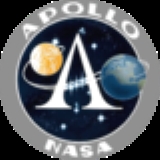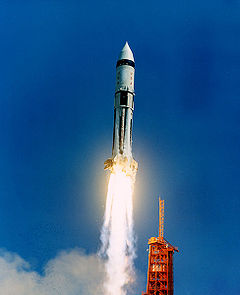
AS-203
Encyclopedia

Saturn IB
The Saturn IB was an American launch vehicle commissioned by the National Aeronautics and Space Administration for use in the Apollo program...
rocket on July 5, 1966. It carried no Apollo Command/Service Module
Apollo Command/Service Module
The Command/Service Module was one of two spacecraft, along with the Lunar Module, used for the United States Apollo program which landed astronauts on the Moon. It was built for NASA by North American Aviation...
spacecraft, as its purpose was to verify the design of the S-IVB
S-IVB
The S-IVB was built by the Douglas Aircraft Company and served as the third stage on the Saturn V and second stage on the Saturn IB. It had one J-2 engine...
rocket stage restart capability that would later be used in the Apollo program to boost astronauts from Earth orbit to a trajectory towards the Moon. It successfully achieved its objectives, but the stage was inadvertently destroyed after four orbits.
Objectives
The purpose of the AS-203 flight was to investigate the effects of weightlessness on the liquid hydrogenLiquid hydrogen
Liquid hydrogen is the liquid state of the element hydrogen. Hydrogen is found naturally in the molecular H2 form.To exist as a liquid, H2 must be pressurized above and cooled below hydrogen's Critical point. However, for hydrogen to be in a full liquid state without boiling off, it needs to be...
fuel in the S-IVB
S-IVB
The S-IVB was built by the Douglas Aircraft Company and served as the third stage on the Saturn V and second stage on the Saturn IB. It had one J-2 engine...
-200 second-stage tank. The lunar missions would use a modified version of the S-IVB-500 as the third stage of the Saturn V
Saturn V
The Saturn V was an American human-rated expendable rocket used by NASA's Apollo and Skylab programs from 1967 until 1973. A multistage liquid-fueled launch vehicle, NASA launched 13 Saturn Vs from the Kennedy Space Center, Florida with no loss of crew or payload...
launch vehicle. This called for the stage to fire briefly to put the spacecraft into a parking Earth orbit, before restarting the engine for flight to the Moon. In order to design this capability, engineers needed to verify that the anti-slosh measures designed to control the hydrogen's location in the tank were adequate, and that the fuel lines and engines could be kept at the proper temperatures to allow engine restart.
In order to keep residual propellants in the tanks on orbit, there would be no Apollo Command/Service Module
Apollo Command/Service Module
The Command/Service Module was one of two spacecraft, along with the Lunar Module, used for the United States Apollo program which landed astronauts on the Moon. It was built for NASA by North American Aviation...
payload as there was on AS-201
AS-201
AS-201 , flown February 26, 1966, was the first unmanned test flight of an entire production Block I Apollo Command/Service Module and the Saturn IB launch vehicle. The spacecraft consisted of the second Block I command module and the first Block I service module...
and AS-202
AS-202
AS-202 was the second unmanned, suborbital test flight of a production Block I Apollo Command/Service Module launched with the Saturn IB launch vehicle. It launched August 25, 1966 and was the first flight which included the spacecraft Guidance and Navigation Control system and fuel cells...
. This was replaced by an aerodynamic nose cone
Nose cone
The term nose cone is used to refer to the forwardmost section of a rocket, guided missile or aircraft. The cone is shaped to offer minimum aerodynamic resistance...
. Also, the full load of liquid oxygen
Liquid oxygen
Liquid oxygen — abbreviated LOx, LOX or Lox in the aerospace, submarine and gas industries — is one of the physical forms of elemental oxygen.-Physical properties:...
oxidizer was shorted slightly so that the amount of hydrogen remaining would approximate that of the Saturn V parking orbit. The tank was equipped with 88 sensors and two TV cameras to record the fuel's behavior.
This was also the first flight of a new type of Instrument Unit that controlled the Saturn rockets during launch, and also the first launch of a Saturn IB from Pad 37B.
Preparation
In the spring of 1966, the decision was made to launch AS-203 before AS-202AS-202
AS-202 was the second unmanned, suborbital test flight of a production Block I Apollo Command/Service Module launched with the Saturn IB launch vehicle. It launched August 25, 1966 and was the first flight which included the spacecraft Guidance and Navigation Control system and fuel cells...
, as the CSM that was to be flown on AS-202 was delayed. The S-IVB stage arrived at Cape Canaveral
Cape Canaveral Air Force Station
Cape Canaveral Air Force Station is an installation of the United States Air Force Space Command's 45th Space Wing, headquartered at nearby Patrick Air Force Base. Located on Cape Canaveral in the state of Florida, CCAFS is the primary launch head of America's Eastern Range with four launch pads...
on 6 April 1966; the S-IB first stage arrived six days later, and the Instrument Unit came two days after that.
On April 19, technicians began to erect the booster at Pad 37B. Once again, the testing regime ran into problems that had plagued AS-201, including cracked solder joints in the printed-circuit boards, requiring over 8,000 to be replaced.
In June 1966, three Saturn rockets could be seen set up on various pads across the Cape: at Pad 39A was a full-size mock-up of the Saturn V; AS-202 was at Pad 34; and AS-203 was at 37B.
Flight
The rocket launched on the first attempt on July 5. The S-IVBS-IVB
The S-IVB was built by the Douglas Aircraft Company and served as the third stage on the Saturn V and second stage on the Saturn IB. It had one J-2 engine...
and IU were inserted into a 100 nmi (185.2 km; 115.1 mi) circular orbit.
The S-IVB design test objectives were carried out on the first two orbits, and the hydrogen was found to behave mostly as predicted, with sufficient control over its location and of engine temperatures required for restart. The next two orbits were used for extra experiments to obtain information of use in future cryogenic stage designs. These included a free-coast experiment to observe and control the negative acceleration of the fuel caused by the small amount of aerodynamic drag on the vehicle; a rapid fuel tank depressurization test; and a closed fuel tank pressurization test.
The closed fuel tank experiment involved pressurizing the hydrogen tank by closing its vents, while depressurizing the oxygen tank by allowing it to continue venting. It was expected that the pressure difference between the two tanks (measured as high as 39.4 pound per square inches (271.7 kPa)) would collapse the common bulkhead separating them, as confirmed in a ground test. The rupture must have occurred during the two-minute loss of signal between the Manned Spacecraft Center
Lyndon B. Johnson Space Center
The Lyndon B. Johnson Space Center is the National Aeronautics and Space Administration's center for human spaceflight training, research and flight control. The center consists of a complex of 100 buildings constructed on 1,620 acres in Houston, Texas, USA...
and the Trinidad
Trinidad
Trinidad is the larger and more populous of the two major islands and numerous landforms which make up the island nation of Trinidad and Tobago. It is the southernmost island in the Caribbean and lies just off the northeastern coast of Venezuela. With an area of it is also the fifth largest in...
tracking station. The Trinidad radar image indicated the vehicle was in multiple pieces, and telemetry was never re-acquired. NASA concluded that a spark or impact must have ignited the propellants, causing an explosion.
Despite the destruction of the stage, the mission was classified as a success, having achieved all of its primary objectives and validating the design concept of the restartable dash-500 version. In September Douglas Aircraft Company
Douglas Aircraft Company
The Douglas Aircraft Company was an American aerospace manufacturer, based in Long Beach, California. It was founded in 1921 by Donald Wills Douglas, Sr. and later merged with McDonnell Aircraft in 1967 to form McDonnell Douglas...
, who built the S-IVB, declared that the stage was operational and could be used on the Saturn V to send men to the Moon.
External links
- http://nssdc.gsfc.nasa.gov/database/MasterCatalog?sc=1966-059A
- Moonport: A History of Apollo Launch Facilities and Operations
- Chariots for Apollo: A History of Manned Lunar Spacecraft

